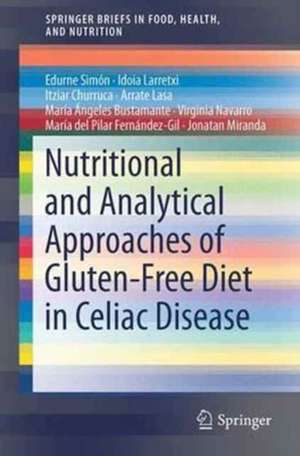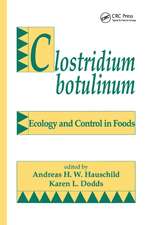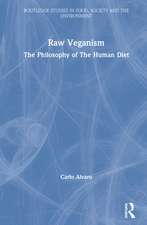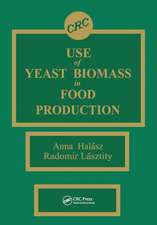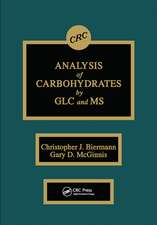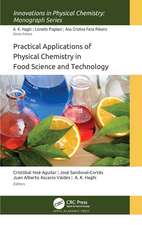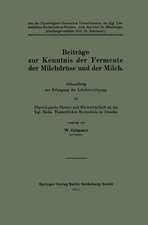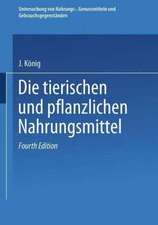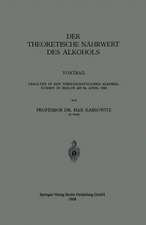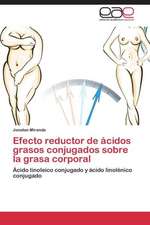Nutritional and Analytical Approaches of Gluten-Free Diet in Celiac Disease: SpringerBriefs in Food, Health, and Nutrition
Autor Edurne Simón, Idoia Larretxi, Itziar Churruca, Arrate Lasa, María Ángeles Bustamante, Virginia Navarro, María del Pilar Fernández-Gil, Jonatan Mirandaen Limba Engleză Paperback – 18 mai 2017
This study by the University of Basque Country Gluten Analysis Laboratory analyzes the gluten free diet from different perspectives. The authors provide background information on gluten, celiac disease, and other pathologies related to gluten intake. Later chapters cover topics such as techniques for gluten detection in foodstuffs and additives, as well as techniques used in complex matrices.
Given that the only effective treatment for celiac disease is a strict, lifelong, gluten-free diet, and that the ingestion of small amounts of gluten can cause major symptoms in gluten intolerants, in recent years there has been an increasing interest in gluten free foodstuffs. In fact, the gluten-free product market has become one of the most prosperous in the field of food and beverages. The book provides a detailed analysis of the nutritional composition of gluten-free foodstuffs and a comparison with their gluten containing analogues.
While targeted towards clinicians and science professionals, such as those working to develop gluten-free foods, it also discusses the energy and nutrient content of a gluten-free diet and offers different nutritional education strategies to improve the eating habits and nutritional status of those living with celiac disease.
Din seria SpringerBriefs in Food, Health, and Nutrition
-
 Preț: 378.12 lei
Preț: 378.12 lei -
 Preț: 381.00 lei
Preț: 381.00 lei -
 Preț: 408.82 lei
Preț: 408.82 lei -
 Preț: 380.07 lei
Preț: 380.07 lei -
 Preț: 381.00 lei
Preț: 381.00 lei -
 Preț: 471.95 lei
Preț: 471.95 lei -
 Preț: 377.18 lei
Preț: 377.18 lei -
 Preț: 379.09 lei
Preț: 379.09 lei -
 Preț: 379.09 lei
Preț: 379.09 lei -
 Preț: 374.46 lei
Preț: 374.46 lei -
 Preț: 374.46 lei
Preț: 374.46 lei -
 Preț: 377.18 lei
Preț: 377.18 lei -
 Preț: 375.45 lei
Preț: 375.45 lei -
 Preț: 374.85 lei
Preț: 374.85 lei -
 Preț: 377.18 lei
Preț: 377.18 lei - 20%
 Preț: 322.50 lei
Preț: 322.50 lei -
 Preț: 374.08 lei
Preț: 374.08 lei -
 Preț: 376.80 lei
Preț: 376.80 lei -
 Preț: 348.40 lei
Preț: 348.40 lei -
 Preț: 380.84 lei
Preț: 380.84 lei -
 Preț: 376.80 lei
Preț: 376.80 lei -
 Preț: 378.34 lei
Preț: 378.34 lei -
 Preț: 382.95 lei
Preț: 382.95 lei -
 Preț: 374.08 lei
Preț: 374.08 lei -
 Preț: 377.95 lei
Preț: 377.95 lei -
 Preț: 377.35 lei
Preț: 377.35 lei -
 Preț: 374.85 lei
Preț: 374.85 lei -
 Preț: 375.84 lei
Preț: 375.84 lei -
 Preț: 376.04 lei
Preț: 376.04 lei -
 Preț: 377.18 lei
Preț: 377.18 lei -
 Preț: 375.62 lei
Preț: 375.62 lei -
 Preț: 411.32 lei
Preț: 411.32 lei -
 Preț: 379.86 lei
Preț: 379.86 lei -
 Preț: 379.30 lei
Preț: 379.30 lei -
 Preț: 376.96 lei
Preț: 376.96 lei -
 Preț: 352.58 lei
Preț: 352.58 lei -
 Preț: 380.25 lei
Preț: 380.25 lei -
 Preț: 373.54 lei
Preț: 373.54 lei -
 Preț: 343.00 lei
Preț: 343.00 lei -
 Preț: 375.45 lei
Preț: 375.45 lei -
 Preț: 375.23 lei
Preț: 375.23 lei -
 Preț: 412.30 lei
Preț: 412.30 lei
Preț: 352.97 lei
Nou
Puncte Express: 529
Preț estimativ în valută:
67.55€ • 70.26$ • 55.77£
67.55€ • 70.26$ • 55.77£
Carte tipărită la comandă
Livrare economică 10-16 aprilie
Preluare comenzi: 021 569.72.76
Specificații
ISBN-13: 9783319533414
ISBN-10: 331953341X
Pagini: 104
Ilustrații: V, 94 p. 8 illus., 7 illus. in color.
Dimensiuni: 155 x 235 x 6 mm
Greutate: 0.21 kg
Ediția:1st ed. 2017
Editura: Springer International Publishing
Colecția Springer
Seria SpringerBriefs in Food, Health, and Nutrition
Locul publicării:Cham, Switzerland
ISBN-10: 331953341X
Pagini: 104
Ilustrații: V, 94 p. 8 illus., 7 illus. in color.
Dimensiuni: 155 x 235 x 6 mm
Greutate: 0.21 kg
Ediția:1st ed. 2017
Editura: Springer International Publishing
Colecția Springer
Seria SpringerBriefs in Food, Health, and Nutrition
Locul publicării:Cham, Switzerland
Cuprins
1. Introduction. Celiac disease and gluten-related disorders.- 2. Gluten: General aspects and international regulations about products for celiac people.- 3. Techniques for gluten analysis.- 4. Evolution of gluten content in foods.- 5. Nutritional and sensorial aspects of gluten-free products.- 6. Gluten free diet. Nutritional status and dietary habits of celiac people.
Notă biografică
The University of Basque Country Gluten Analysis Laboratory has worked on the analysis of gluten since 1998. Researchers have participated in collaborative trials designed to validate kits for gluten determination based on ELISA techniques (Ingenasa, Biopharm and Leiden University Medical Center) and those of other laboratories. The lab received ISO 17025 accreditation for gluten analysis in foods, additives and parapharmacy products in 2009. In 2014 the lab extended its detection range, and as of now is the only laboratory in Spain with ISO 17025 accreditation for gluten determination in complex food matrices (hydrolyzed or fermented foods).
Textul de pe ultima copertă
This study by the University of Basque Country Gluten Analysis Laboratory analyzes the gluten free diet from different perspectives. The authors provide background information on gluten, celiac disease, and other pathologies related to gluten intake. Later chapters cover topics such as techniques for gluten detection in foodstuffs and additives, as well as techniques used in complex matrices.
Given that the only effective treatment for celiac disease is a strict, lifelong, gluten-free diet, and that the ingestion of small amounts of gluten can cause major symptoms in gluten intolerants, in recent years there has been an increasing interest in gluten free foodstuffs. In fact, the gluten-free product market has become one of the most prosperous in the field of food and beverages. The book provides a detailed analysis of the nutritional composition of gluten-free foodstuffs and a comparison with their gluten containing analogues.
While targeted towards clinicians and science professionals, such as those working to develop gluten-free foods, it also discusses the energy and nutrient content of a gluten-free diet and offers different nutritional education strategies to improve the eating habits and nutritional status of those living with celiac disease.
Caracteristici
Provides background information on gluten, celiac disease, and other pathologies related to gluten intake, such as gluten allergy and gluten sensibility Describes the evolution of gluten content in foods, and techniques for gluten detection in foodstuffs and additives Analyzes the nutritional composition of gluten-free foods and the nutritional status and dietary habits of celiac people in comparison to the general population Includes supplementary material: sn.pub/extras
